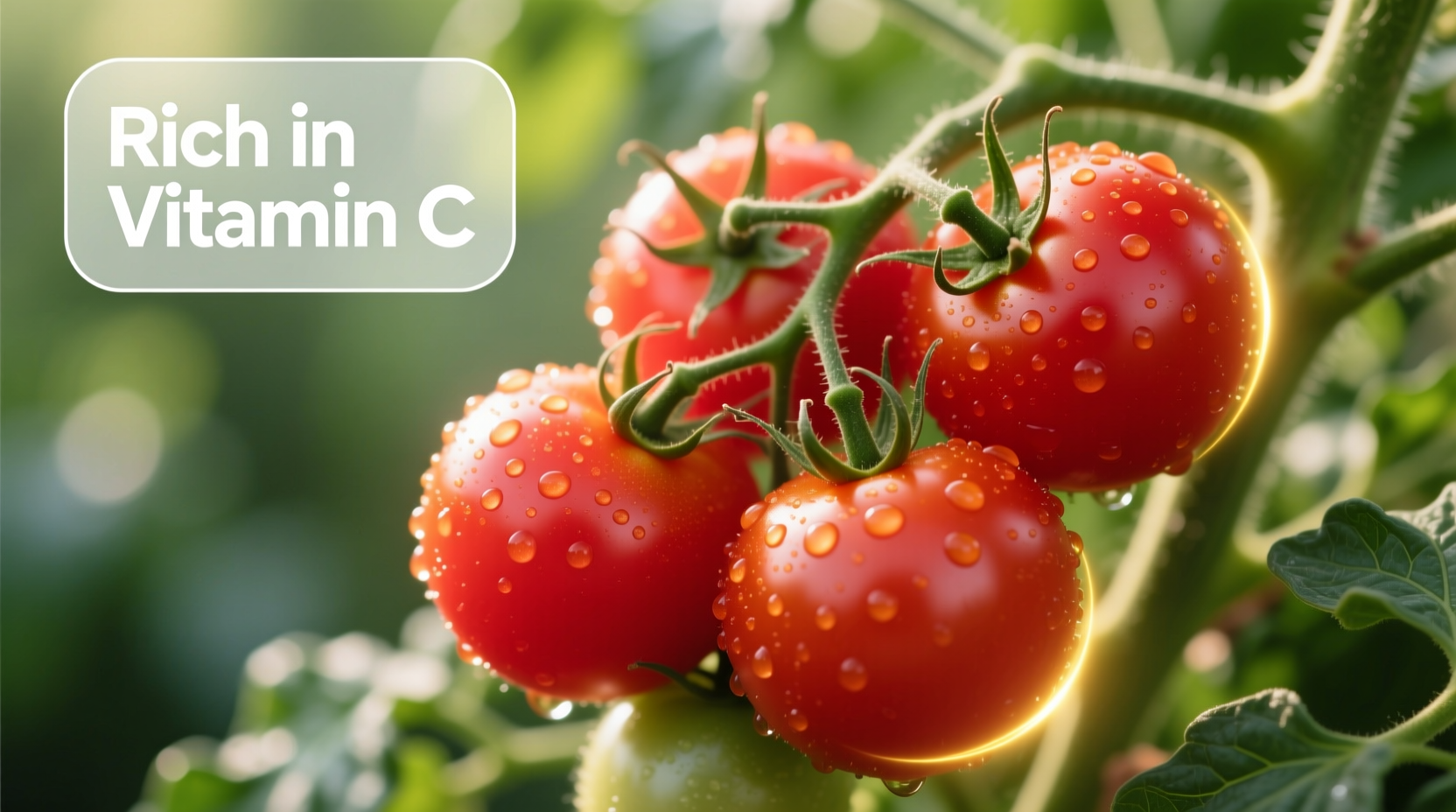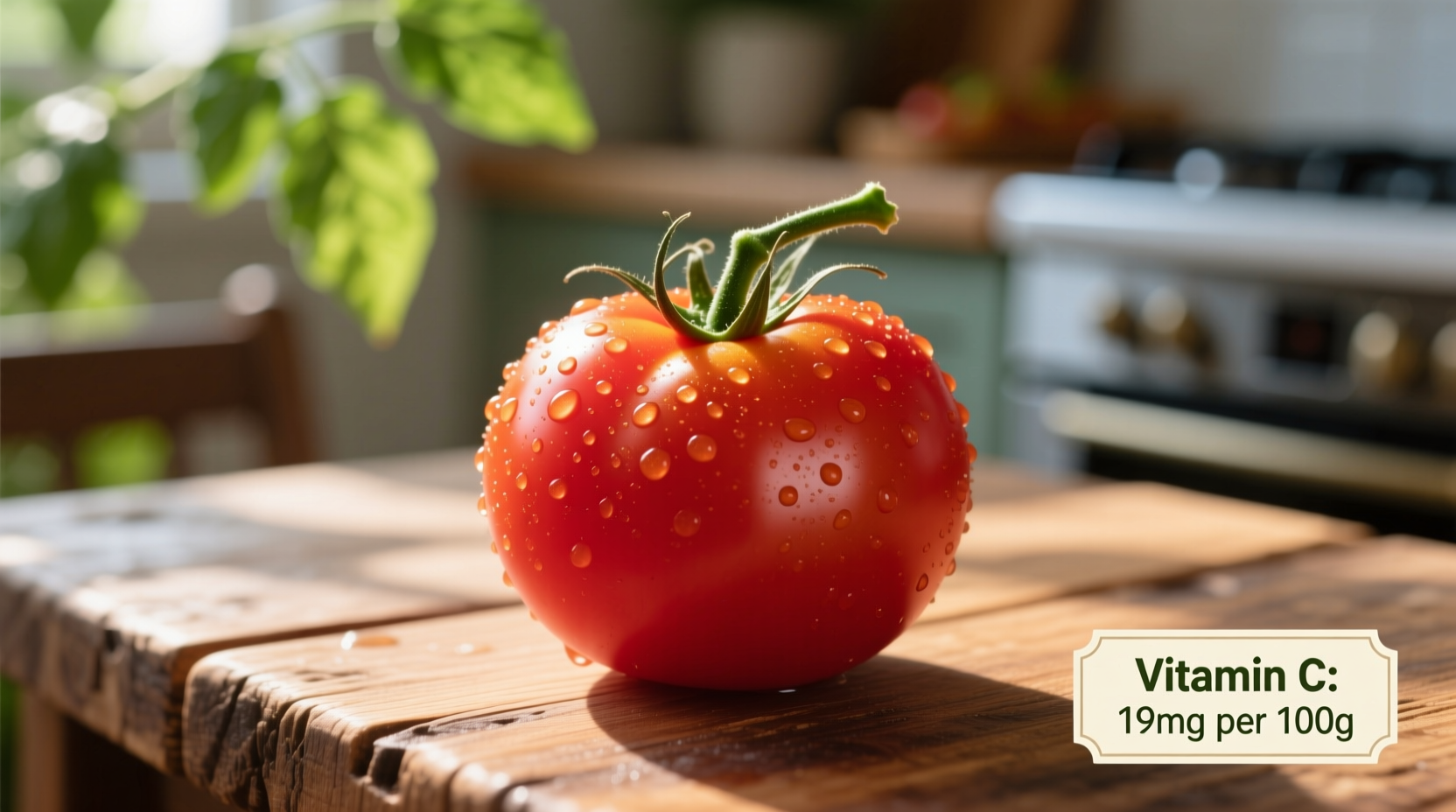Yes, tomatoes contain significant amounts of vitamin C—approximately 13.7 mg per 100 grams of raw tomato. This essential nutrient supports immune function, skin health, and iron absorption, making tomatoes a valuable addition to a balanced diet. One medium tomato provides about 28% of the recommended daily vitamin C intake for adults.
When you bite into a juicy tomato, you're not just enjoying its fresh flavor—you're fueling your body with a powerful antioxidant. As a food writer who's documented culinary traditions from Mediterranean markets to Southeast Asian farms, I've witnessed firsthand how this vibrant fruit (yes, botanically a fruit!) delivers surprising nutritional benefits across global cuisines. In this guide, you'll discover exactly how much vitamin C you get from tomatoes, how it compares to other sources, and practical ways to maximize your intake.
Tomato Vitamin C: The Scientific Breakdown
According to USDA FoodData Central, a single medium tomato (123g) contains 22.7 mg of vitamin C, meeting nearly one-third of the recommended daily value for adults. This water-soluble vitamin plays critical roles in collagen synthesis, wound healing, and neutralizing harmful free radicals. Unlike some nutrients, your body can't store vitamin C, making regular dietary intake essential.
The vitamin C content varies across tomato varieties. Research published in the Journal of Agricultural and Food Chemistry shows that cherry tomatoes contain up to 30% more vitamin C than standard globe tomatoes. This difference stems from their higher skin-to-flesh ratio, as vitamin C concentrates in the outer layers.
| Food Source | Vitamin C (per 100g) | Percent Daily Value |
|---|---|---|
| Raw Tomato | 13.7 mg | 15% |
| Orange | 53.2 mg | 59% |
| Red Bell Pepper | 127.7 mg | 142% |
| Strawberries | 58.8 mg | 65% |
How Tomato Vitamin C Compares to Common Sources
While tomatoes aren't the highest vitamin C source, they offer unique advantages. Unlike citrus fruits that deliver vitamin C in acidic packages, tomatoes provide this nutrient with lycopene and other phytonutrients that enhance absorption. The National Institutes of Health notes that vitamin C in tomatoes remains stable during ripening, unlike in many fruits where levels decrease as they mature.
A fascinating historical perspective: When Spanish explorers brought tomatoes to Europe in the 16th century, they unknowingly introduced a valuable source of scurvy prevention. Though vitamin C wasn't isolated until 1928, Mediterranean populations consuming tomato-rich diets showed lower rates of deficiency diseases compared to Northern Europeans relying on preserved meats.
Factors That Affect Vitamin C Content
Your preparation method significantly impacts how much vitamin C you actually consume from tomatoes. Research from the University of California's Agriculture Department reveals these key factors:
- Freshness matters: Vitamin C degrades over time—tomatoes lose about 15% of their content within 7 days of harvest at room temperature
- Cutting technique: Slicing exposes more surface area to oxygen, accelerating nutrient loss
- Cooking effects: Brief cooking (like in pasta sauces) increases bioavailability by breaking down cell walls, but prolonged high-heat cooking destroys up to 30% of vitamin C
- Storage conditions: Refrigeration slows degradation but doesn't stop it completely

Maximizing Vitamin C Absorption from Tomatoes
Make the most of your tomato consumption with these evidence-based strategies:
Pair tomatoes with iron-rich plant foods like spinach or lentils—the vitamin C enhances non-heme iron absorption by up to 300%, according to a study in the American Journal of Clinical Nutrition. Enjoy tomatoes at room temperature rather than chilled, as cold temperatures temporarily reduce nutrient bioavailability. For cooked dishes, add tomatoes late in the cooking process and avoid boiling whenever possible.
When selecting tomatoes, choose deeply colored varieties with firm skins. The USDA's Phytochemical Screening Project confirms that deeper red hues correlate with higher concentrations of both lycopene and vitamin C. Seasonal, vine-ripened tomatoes typically contain 20-25% more vitamin C than off-season greenhouse varieties.
Common Misconceptions About Tomato Nutrition
Many believe processed tomato products like ketchup or canned tomatoes lose all nutritional value. While processing does reduce vitamin C content by 10-25%, these products still provide meaningful amounts. Interestingly, tomato paste concentrates nutrients through water removal—two tablespoons contain about 10mg of vitamin C.
Another myth suggests that only citrus fruits provide significant vitamin C. In reality, many vegetables including tomatoes, bell peppers, and broccoli deliver comparable or higher amounts per serving. The key is consistent daily consumption from multiple sources.
Practical Applications for Daily Nutrition
Incorporate tomatoes strategically throughout your day: add sliced tomatoes to morning avocado toast, include them in lunchtime salads, and use fresh tomato salsa with dinner. For maximum benefit, consume tomatoes within two days of purchase and store them stem-side down at room temperature until fully ripe.
When traveling or during winter months when fresh tomatoes are less available, consider sun-dried tomatoes—though processing reduces vitamin C content by about 50%, their concentrated form still provides meaningful amounts per serving. Just be mindful of added salt in commercial preparations.











 浙公网安备
33010002000092号
浙公网安备
33010002000092号 浙B2-20120091-4
浙B2-20120091-4